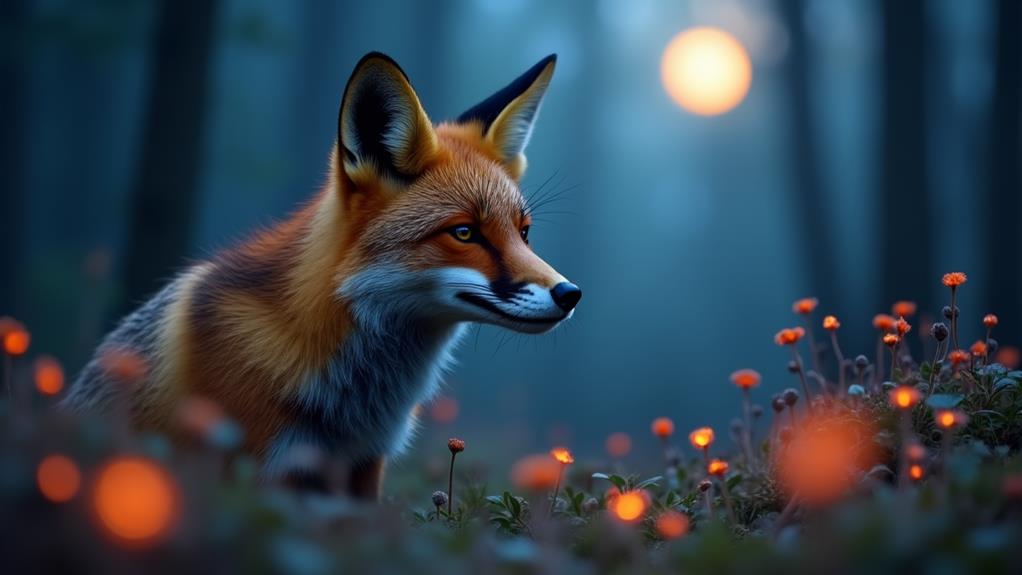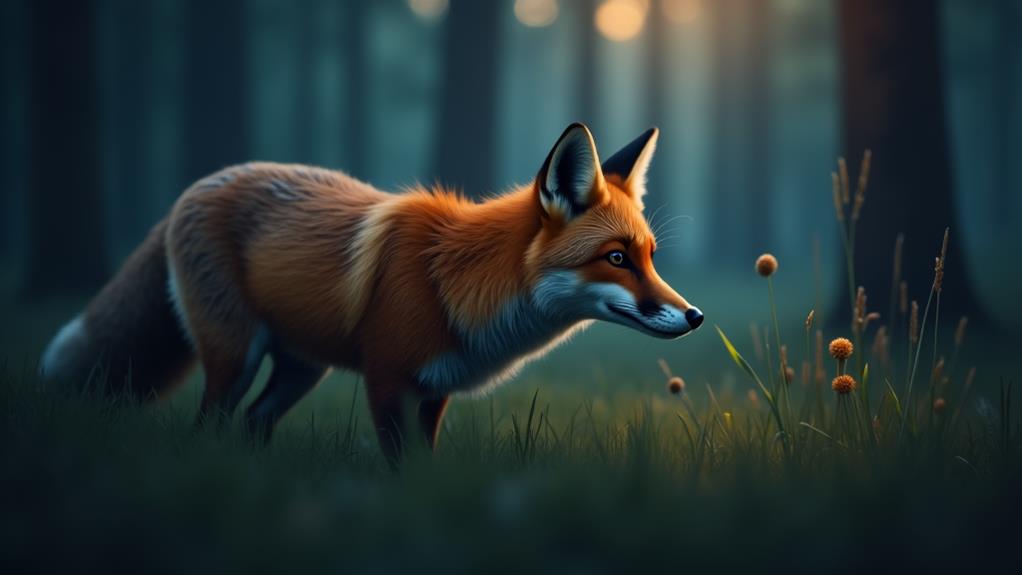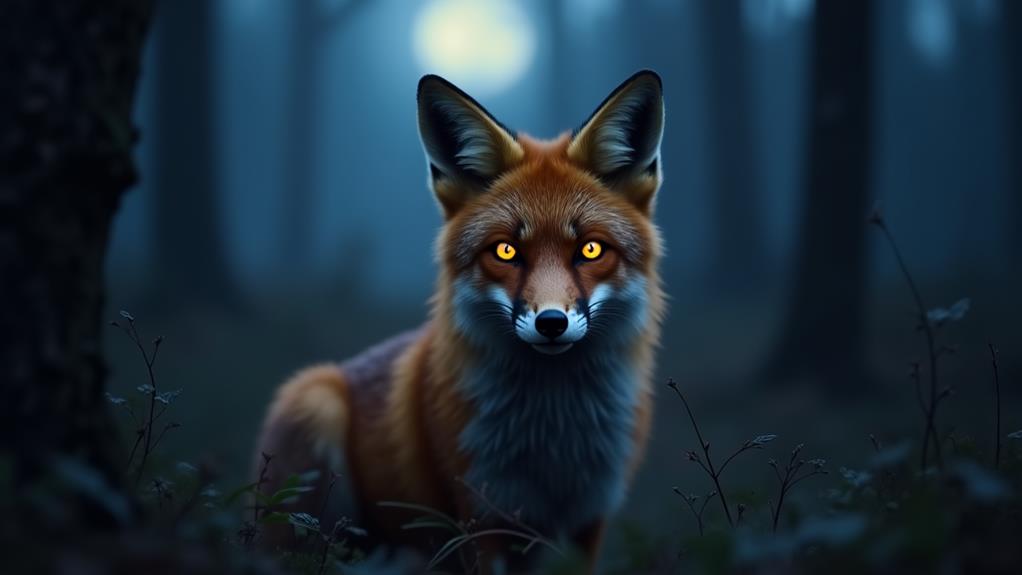Absolutely, foxes are night vision experts! Their eyes are packed with special cells called rods, which help them see well in low light. Plus, they have a nifty feature called the tapetum lucidum, which reflects light and gives their eyes that cool green glow. With a wide field of view, they can spot movement up to 260 degrees, perfect for hunting in the dark. Their ears can swivel around to catch sounds, making them even better at playing hide and seek with prey. Stick around, and you'll discover even more amazing facts about these clever creatures!
Contents
Overview of Fox Anatomy

When you look at a fox, you'll notice its remarkable anatomy, perfectly adapted for survival in varied environments. Their eyes are a standout feature, designed to make them exceptional nocturnal hunters. You see, foxes have a high rod density in their retinas, which enhances their ability to see in low-light conditions. This means they can spot a tasty snack in the dark much better than we can! This adaptation is essential for their survival as they often hunt at night to take advantage of their prey's vulnerability.
But that's not all—foxes also have a cool layer called the tapetum lucidum behind their retina. This reflective layer bounces light back through the retina, giving them even better night vision. If you ever catch a glimpse of a fox at night and see their eyes glowing green, it's because of this neat feature!
In addition to their vision, foxes have evolved fascinating behavioral adaptations as nocturnal hunters, allowing them to thrive in various habitats, including urban areas where competition for food may be high diverse habitats of foxes.
Another fascinating aspect of fox anatomy is their wide field of view—about 260 degrees. This helps them navigate and hunt effectively while darting through the vegetation. However, they do have myopic eyes, so while they excel in movement detection, spotting stationary objects can be a bit tricky for them. Isn't nature amazing?
Visual Capabilities in Low Light
How do foxes manage to hunt so effectively in the dark? Their incredible visual capabilities make them remarkable nocturnal hunters! With a high rod density in their retinas, foxes excel in low-light conditions, allowing them to spot movement even when it's nearly pitch black. This makes them true specialists when the sun goes down.
One fascinating feature is the tapetum lucidum, a reflective layer behind their retinas. It boosts their night vision efficiency, giving their eyes a striking green glow at night. Talk about a shining star!
While their myopic vision helps them navigate through dense vegetation, they can struggle with stationary objects. So, a game of hide and seek mightn't be their forte.
Foxes also enjoy a wide field of view—around 260 degrees! This panoramic perspective is helpful for spotting all the little critters scurrying about.
Plus, they can switch between rod and cone dominance depending on the light levels, giving them the flexibility to hunt during dusk and dawn.
Hearing Adaptations for Night Hunting

Foxes have developed remarkable hearing adaptations that greatly enhance their nighttime hunting success. Their ears aren't just adorable; they're flexible and can rotate about 150 degrees independently! This means they can pinpoint sounds with incredible accuracy in the dark, similar to how Arctic foxes master hunting techniques.
They can hear frequencies from 300 Hz to 15 kHz, with peak sensitivity at around 3.5 kHz, making it easy for them to detect prey rustling in the underbrush.
When it comes to sound location, foxes show over 90% accuracy between 900 Hz and 14 kHz. They've a specially structured tympanic bulla, which helps them catch low-frequency vibrations too. This means they can locate that sneaky little rabbit hiding in the grass while you're just trying to enjoy a peaceful evening!
Experiments reveal that these clever hunters rely heavily on auditory cues during their nocturnal escapades. So, the next time you see a fox darting through the night, remember that their extraordinary hearing plays a crucial role in their ability to catch prey, transforming their nighttime adventures into a symphony of survival.
Isn't nature just fascinating?
Unique Features of Fox Eyes
In addition to their impressive hearing abilities, foxes also have unique eye adaptations that make them formidable nocturnal hunters. You might be surprised to learn that foxes use their eyes like pros when prowling around in the dark. With a high rod density in their retinas, they can see exceptionally well in low light, making them perfect for nighttime escapades.
But that's not all. Ever heard of the tapetum lucidum? This nifty reflective layer behind their retina helps foxes maximize available light, turning their eyes into glowing green beacons at night. It's like having built-in night vision goggles!
Plus, they enjoy an impressive field of view of about 260 degrees, which helps them spot movement and potential dinner. Foxes also sport bright amber-yellow irises thanks to lipochrome pigment. This feature helps reduce glare during bright-light conditions.
And when lighting conditions change, they can switch between rod and cone dominance, so they handle anything from twilight to total darkness like champs. Next time you see a fox at night, just remember how incredible their eyes are and appreciate their adaptations!
Role of Other Senses in Hunting

What makes foxes such effective hunters at night? It's not just their keen eyesight; they've got a whole toolbox of skills! Their exceptional hearing, for instance, allows them to pick up sounds from 300 Hz to a whopping 15 kHz. This helps them locate their prey—even when it's hidden in dense bushes.
In addition to sound detection, foxes possess bushy tails that provide balance during their agile movements in pursuit of food, demonstrating their physical adaptations for survival. Imagine trying to find a needle in a haystack; that's how foxes can track down rustling noises and sneaky critters.
But wait, there's more! Their ears can rotate about 150 degrees, giving them a perfect listening apparatus. As they hunt under the moonlight, their acute sense of movement kicks in, sharpening their visual acuity. This ability helps them spot their prey even when it's practically pitch dark.
While they do have a sense of smell, it plays a less essential role than sight and hearing in their nocturnal adventures.
In combination, these senses make foxes amazing nighttime hunters. So, the next time you see a fox, remember—it's not just their trendy fur; it's a whole symphony of senses working together to snag dinner! Foxes truly know how to hunt smart!
Final Thoughts
So, while you might think foxes just get lucky when they're hunting at night, their adaptations for low light and sharp hearing tell a different story. They've got unique eyes and ears that help them find food even when it's dark out. Sure, not every animal can be a night owl—or in this case, a night fox! But these clever creatures have mastered the art of nighttime survival, making them truly fascinating to watch and learn about.














